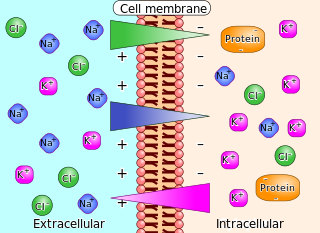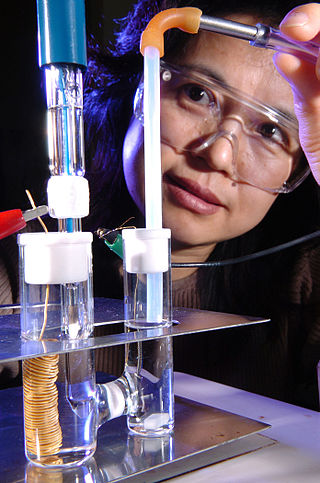Related Research Articles

Electrochemistry is the branch of physical chemistry concerned with the relationship between electrical potential difference and identifiable chemical change. These reactions involve electrons moving via an electronically conducting phase between electrodes separated by an ionically conducting and electronically insulating electrolyte.

Compton scattering is the quantum theory of high frequency photons scattering following an interaction with a charged particle, usually an electron. Specifically, when the photon hits electrons, it releases loosely bound electrons from the outer valence shells of atoms or molecules.

Activated carbon, also called activated charcoal, is a form of carbon commonly used to filter contaminants from water and air, among many other uses. It is processed (activated) to have small, low-volume pores that greatly increase the surface area available for adsorption or chemical reactions that can be thought of as a microscopic "sponge" structure. Activation is analogous to making popcorn from dried corn kernels: popcorn is light, fluffy, and its kernels have a high surface-area-to-volume ratio. Activated is sometimes replaced by active.

Polenta is an Italian dish of boiled cornmeal that was historically made from other grains. It may be allowed to cool and solidify into a loaf that can be baked, fried, or grilled.

In electrochemistry, cyclic voltammetry (CV) is a type of voltammetric measurement where the potential of the working electrode is ramped linearly versus time. Unlike in linear sweep voltammetry, after the set potential is reached in a CV experiment, the working electrode's potential is ramped in the opposite direction to return to the initial potential. These cycles in potential are repeated until the voltammetric trace reaches a cyclic steady state. The current at the working electrode is plotted versus the voltage at the working electrode to yield the cyclic voltammogram. Cyclic voltammetry is generally used to study the electrochemical properties of an analyte in solution or of a molecule that is adsorbed onto the electrode.

Dielectric spectroscopy measures the dielectric properties of a medium as a function of frequency. It is based on the interaction of an external field with the electric dipole moment of the sample, often expressed by permittivity.

Electron paramagnetic resonance (EPR) or electron spin resonance (ESR) spectroscopy is a method for studying materials that have unpaired electrons. The basic concepts of EPR are analogous to those of nuclear magnetic resonance (NMR), but the spins excited are those of the electrons instead of the atomic nuclei. EPR spectroscopy is particularly useful for studying metal complexes and organic radicals. EPR was first observed in Kazan State University by Soviet physicist Yevgeny Zavoisky in 1944, and was developed independently at the same time by Brebis Bleaney at the University of Oxford.

An electrochemical gradient is a gradient of electrochemical potential, usually for an ion that can move across a membrane. The gradient consists of two parts:
In flow chemistry, also called reactor engineering, a chemical reaction is run in a continuously flowing stream rather than in batch production. In other words, pumps move fluid into a reactor, and where tubes join one another, the fluids contact one another. If these fluids are reactive, a reaction takes place. Flow chemistry is a well-established technique for use at a large scale when manufacturing large quantities of a given material. However, the term has only been coined recently for its application on a laboratory scale by chemists and describes small pilot plants, and lab-scale continuous plants. Often, microreactors are used.

An electrocatalyst is a catalyst that participates in electrochemical reactions. Electrocatalysts are a specific form of catalysts that function at electrode surfaces or, most commonly, may be the electrode surface itself. An electrocatalyst can be heterogeneous such as a platinized electrode. Homogeneous electrocatalysts, which are soluble, assist in transferring electrons between the electrode and reactants, and/or facilitate an intermediate chemical transformation described by an overall half reaction. Major challenges in electrocatalysts focus on fuel cells.
In electrochemistry, polarization is a collective term for certain mechanical side-effects by which isolating barriers develop at the interface between electrode and electrolyte. These side-effects influence the reaction mechanisms, as well as the chemical kinetics of corrosion and metal deposition. In a reaction, the attacking reagents can displace the bonding electrons. This electronic displacement in turn may be due to certain effects, some of which are permanent, and the others are temporary. Those effects which are permanently operating in the molecule are known as polarization effects, and those effects which are brought into play by attacking reagent are known as polarisability effects.
Electrochemical regeneration of activated carbon adsorbents such as granular activated carbon present an alternative to thermal regeneration or land filling at the end of useful adsorbent life. Continuous adsorption-electrochemical regeneration encompasses the adsorption and regeneration steps, typically separated in the bulk of industrial processes due to long adsorption equilibrium times, into one continuous system. This is possible using a non-porous, electrically conducting carbon derivative called Nyex. The non-porosity of Nyex allows it to achieve its full adsorptive capacity within a few minutes and its electrical conductivity allows it to form part of the electrode in an electrochemical cell. As a result of its properties Nyex can undergo quick adsorption and fast electrochemical regeneration in a combined adsorption-electrochemical regeneration cell achieving 100% regeneration efficiency.
Electrochemical engineering is the branch of chemical engineering dealing with the technological applications of electrochemical phenomena, such as electrosynthesis of chemicals, electrowinning and refining of metals, flow batteries and fuel cells, surface modification by electrodeposition, electrochemical separations and corrosion.
Plasma-activated bonding is a derivative, directed to lower processing temperatures for direct bonding with hydrophilic surfaces. The main requirements for lowering temperatures of direct bonding are the use of materials melting at low temperatures and with different coefficients of thermal expansion (CTE).

A supercapacitor (SC), also called an ultracapacitor, is a high-capacity capacitor, with a capacitance value much higher than solid-state capacitors but with lower voltage limits. It bridges the gap between electrolytic capacitors and rechargeable batteries. It typically stores 10 to 100 times more energy per unit volume or mass than electrolytic capacitors, can accept and deliver charge much faster than batteries, and tolerates many more charge and discharge cycles than rechargeable batteries.

Park Electrochemical Corp, now called the Park Aerospace Corp, is a Melville, New York-based materials manufacturer for the telecommunications, Internet infrastructure, high-end computing, and aerospace industries. It produces high-technology digital and radio frequency(RF)/microwave printed circuit material products, composite materials. Its printed circuit materials are used for complex multilayer printed circuit boards and other electronic interconnection systems, such as multilayer back-planes, wireless packages, high-speed/low-loss multilayers, and high density interconnects (HDIs). Its core capabilities are polymer chemistry formulation and coating technology.

María Antonia Herrero is a chemist who works in the faculty of chemical sciences at the University of Castilla–La Mancha (UCLM) in Ciudad Real. Her work focuses on chemical nanomaterials, with research undertaken at the same university.

Marken Michel is an American professional football wide receiver for the Calgary Stampeders of the Canadian Football League (CFL). He played college football at UMass before signing with the Minnesota Vikings as an undrafted free agent in 2016. Michel has also been a member of the Philadelphia Eagles, Carolina Panthers and Washington Football Team / Commanders of the NFL.
Remediation of per- and polyfluoroalkyl substances refers to the destruction or removal of per- and polyfluoroalkyl substances (PFASs) from the environment. PFASs are a group of synthetic organofluorine compounds, used in diverse products such as non-stick cookware and firefighting foams, that have attracted great concern as persistent organic pollutants. Because they are pervasive and have adverse effects, much interest has focused on their removal.
References
- ↑ Microwave activation of electrochemical processes Compton. R, Coles. A and F. Marken. 1998. Microwave activation of electrochemical processes at microelectrodes. Chemical Communications. Accessed: 11/04/18